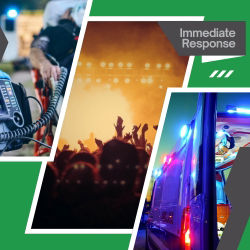What To Consider When Creating an Event Safety Plan
- txelitemedical9
- Jun 11
- 4 min read

If you’re planning any type of event — from a public sporting event to a summertime city festival to a private corporate party — make sure a comprehensive event safety plan is prominent on your event planning to-do list.
What is an Event Safety Plan?
An event safety plan considers your unique needs for effectively handling emergencies that could pop up. You may want to consider security measures, as most people do these days, but also other hazards such as weather preparedness and emergency medical services.
If you holding a concert event outside in July, have you considered how you would handle a heatstroke scenario? What about an accidental overdose or a cardiac arrest. Any of these events could derail an otherwise perfect event. But when an emergency happens — as they often do — your event safety plan can help prevent a bad situation from becoming tragic.
A comprehensive event safety plan published by a university in Michigan, for example, features not just fire prevention, generators, and traffic flow, but also ensuring appropriate first aid stations, means of communication between event personnel and the emergency medical staff, an emergency response plan, and more.
Identifying Hazards to Increase Event Safety & Mitigate Risk
When creating an event safety plan, you must identify hazards that could be associated with the event. Hazards can include:
Human hazards like the expected crowd size and behavior
Technological hazards such as electrical equipment, utility lines, and mechanical systems
Natural hazards such as the physical location being next to a river, toxic plants that children could ingest being present among the landscaping and much more
Environmental hazards such as the weather or wildfire
Your event safety plan’s risk assessment may rate risks based on the severity of the consequence and the likelihood of it to happen.
Controlling Risks to Improve Event Safety

Once hazards are identified, you can determine ways to mitigate the risks from the hazard. Perhaps your event safety plan will include eliminating the risk — such as removing a poisonous plant from the landscape. You might choose to substitute hazards deemed necessary with less dangerous alternatives.
For example, if your event features a firepit for ambiance, you could substitute an open bonfire pit for an enclosed steel firepit with a mesh screen. Depending on the size of your event, you may choose to engineer a way to isolate the hazard such as adding a safety fence along the river’s edge. You might hire a lifeguard for a corporate retreat on the beach.
There are as many ways to mitigate risks from hazards as there are hazards, but no matter how much you reduce risks — you should always have a plan for emergencies.
Emergency Medical Services for Event Safety
Having emergency medical professionals onsite at your event can reduce your liability and increase peace of mind for not just you, but also your guests. When creating an event safety plan, consider what your needs might include specific to event medical services.
Will you need one medical professional on standby at a first aid station or could you potentially need a full team of skilled paramedics on hand?
To answer this, you will need to assess all risks of your event — not just hazards. You’ll consider the expected size of the crowd at your event, the context and activities at your event, and more. Consider these possible emergencies:
Even if your event doesn’t include alcohol, alcohol could be brought in by an attendee. If alcohol was left where a child could access it, would you be prepared to handle that? What about if someone gets alcohol poisoning?
Several of your attendees are allergic to latex, so you were careful to ensure no latex utensils were used in food preparation and no latex balloons were brought in as decorations. That doesn’t mean that a vendor or attendee won’t unknowingly bring latex items to your event. Would you be prepared?
An attendee could suffer a sudden cardiac arrest or stroke. How long would it take an emergency vehicle to arrive on scene?
An employee of a vendor accidentally drops a pill on the ground. A child finds it, thinks it’s candy and eats it. Would anyone there be able to assess the child’s condition before it’s too late?
Legal Considerations for Event Safety Planning
Event safety planning isn’t just the right thing to do to protect your guests, it’s frequently required by local authorities or insurance companies. You may be required to have a fire marshal sign off on your event. You may be required to obtain a health department permit. And you may be required to have a first aid station or emergency personnel on the grounds.
Planning for Emergencies at Your Event
No matter how much you try to mitigate the risk from hazards at your event, there will always be the potential for accidents and medical emergencies. That means making sure your event safety plan includes procedures for dealing with the emergency once it’s happened.
That’s where Elite Medical Services comes in. We offer medical services for events of every size all around the nation. We can help you assess the risks of your event and provide emergency medical services to suit your specific needs. Contact us today to make us a part of your event safety plan.





Comments